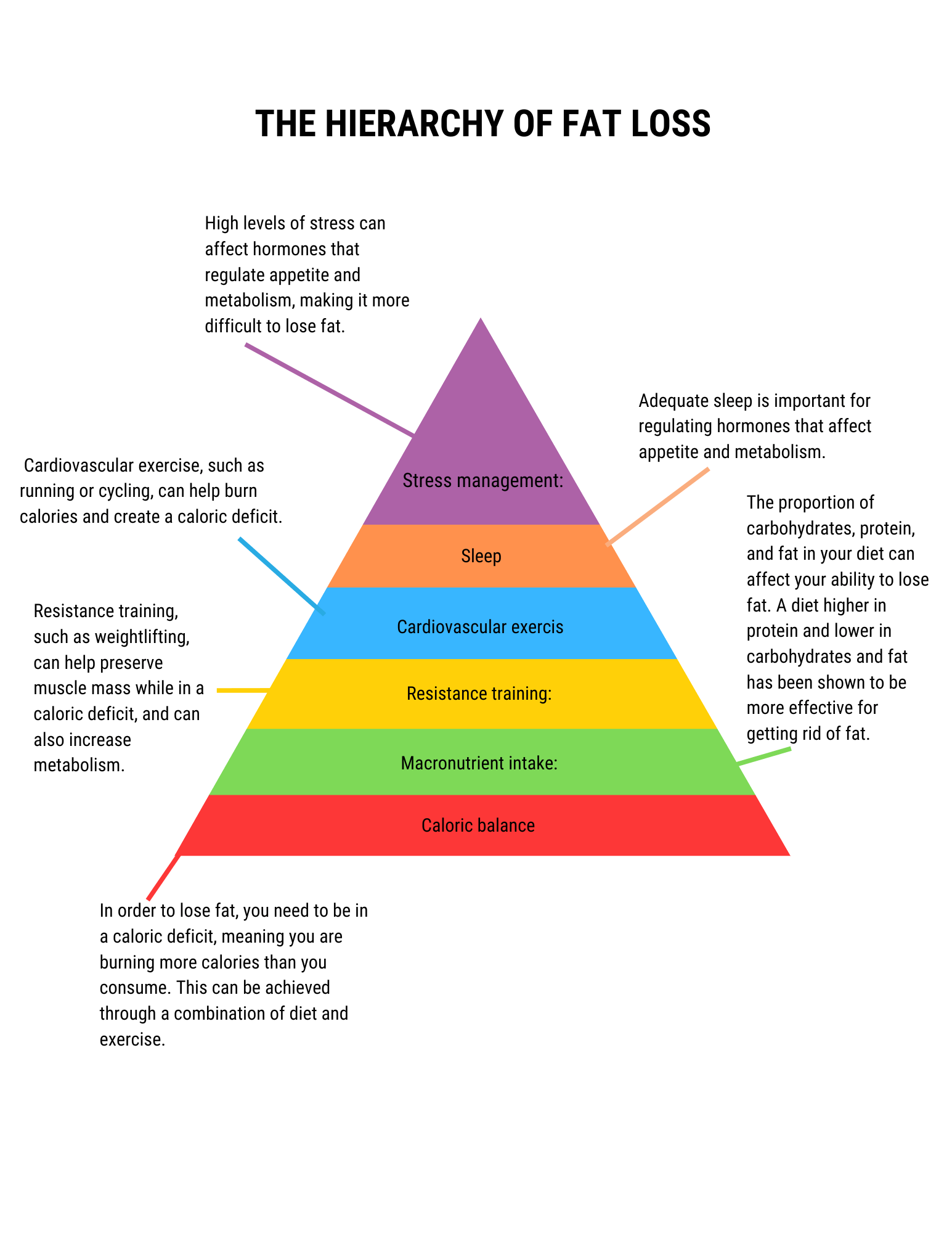

Fat loss is a complex process that involves several factors, including diet, exercise, sleep, and stress management. To optimize fat loss and achieve a healthy body composition, it's important to prioritize these factors and adhere to some key principles. In this article, we'll review the hierarchy of fat loss, explore some key studies on this topic, and provide potential solutions to common issues.
The hierarchy of fat loss is a framework that outlines the most important factors for achieving fat loss in a healthy and sustainable manner. The hierarchy is often presented as a pyramid, with the most important factors at the base and the least important at the top. The key factors, in order of importance, are:
Caloric balance: To lose fat, it's necessary to maintain a caloric deficit, which means consuming fewer calories than you burn through physical activity and daily living. This is the most important factor for fat loss, as it creates the energy imbalance necessary for the body to mobilize stored fat and use it for fuel.
Macronutrient intake: Consuming an adequate amount of protein is crucial for maintaining muscle mass, which is important for overall health and metabolism. Adequate carbohydrate and fat intake is also important for providing energy and supporting hormonal balance.
Resistance training: Engaging in regular resistance training is important for preserving and building muscle mass, which can help maintain a healthy metabolism and body composition.
Cardiovascular exercise: Engaging in regular cardiovascular exercise is important for overall health and fitness, and can also support fat loss by increasing energy expenditure and promoting cardiovascular health.
Sleep: Getting adequate sleep is important for regulating hormones that affect appetite, metabolism, and fat storage, as well as supporting overall health and well-being.
Stress management: Managing stress effectively is important for regulating cortisol levels, which can affect appetite, metabolism, and fat storage.
Now, let's review some key studies on the hierarchy of fat loss and its components:
Caloric balance: A study published in the New England Journal of Medicine compared four popular diets and found that weight loss was correlated with caloric restriction, regardless of the macronutrient composition of the diet. This study supports the importance of creating a caloric deficit for fat loss.
Macronutrient intake: A study published in the American Journal of Clinical Nutrition found that consuming a high-protein diet was more effective for promoting fat loss and preserving muscle mass than a standard-protein diet. This study supports the importance of adequate protein intake for fat loss.
Resistance training: A study published in the Journal of Applied Physiology found that resistance training was effective for preserving muscle mass during a period of caloric restriction, which can help maintain metabolic rate and body composition. This study supports the importance of resistance training for fat loss.
Cardiovascular exercise: A study published in the International Journal of Obesity found that cardiovascular exercise was effective for reducing body fat and improving cardiovascular health, even in the absence of caloric restriction. This study supports the importance of cardiovascular exercise for fat loss and overall health.
Sleep: A study published in the American Journal of Clinical Nutrition found that sleep deprivation was associated with increased levels of hunger hormones and decreased levels of satiety hormones, which can lead to increased caloric intake and decreased energy expenditure. This study supports the importance of adequate sleep for regulating hormones that affect appetite and metabolism.
Stress management: A study published in the journal Obesity found that stress was associated with increased levels of cortisol, which can promote fat storage and impair insulin sensitivity. This study supports the importance of stress management for regulating cortisol levels and promoting fat loss.
To optimize getting rid of fat and address potential issues that may arise when trying to adhere to the hierarchy of fat loss. Here are some common issues and potential solutions:
Difficulty creating a caloric deficit: One common issue is difficulty creating a caloric deficit, especially for those who are new to tracking their food intake. A potential solution is to start with a moderate caloric deficit and adjust as needed based on progress. Tracking food intake using a food diary or app can also be helpful for creating awareness and accountability.
Inadequate protein intake: Another common issue is inadequate protein intake, which can lead to muscle loss and decreased metabolic rate. A potential solution is to prioritize protein-rich foods such as lean meats, poultry, fish, eggs, dairy, and plant-based protein sources. Supplementing with protein powder may also be helpful for those who have difficulty meeting their protein needs through food alone.
Lack of resistance training: Some individuals may struggle with incorporating resistance training into their routine, either due to lack of knowledge or motivation. A potential solution is to seek guidance from a qualified personal trainer or coach, or to participate in group fitness classes that incorporate resistance training. Starting with bodyweight exercises or resistance bands can also be a good way to build strength and confidence.
Boredom with cardiovascular exercise: Some individuals may struggle with sticking to a regular cardiovascular exercise routine due to boredom or lack of enjoyment. A potential solution is to try different types of cardiovascular exercise, such as hiking, swimming, cycling, or dance classes. Incorporating interval training or high-intensity workouts can also be a good way to add variety and challenge to a cardiovascular routine.
Sleep disturbances: Some individuals may struggle with getting adequate sleep due to work, family, or lifestyle factors. A potential solution is to prioritize sleep hygiene by establishing a regular sleep routine, avoiding caffeine and alcohol before bedtime, and creating a sleep-conducive environment. Relaxation techniques such as deep breathing or meditation may also be helpful for promoting relaxation and sleep quality.
Difficulty managing stress: Finally, some individuals may struggle with managing stress effectively, which can lead to increased cortisol levels and decreased fat loss. A potential solution is to prioritize stress management by incorporating relaxation techniques such as yoga, meditation, or deep breathing into a daily routine. Seeking social support from friends or a mental health professional can also be helpful for managing stress and promoting overall well-being.
The hierarchy of fat loss provides a framework for optimizing fat loss in a healthy and sustainable manner. By prioritizing caloric balance, macronutrient intake, resistance training, cardiovascular exercise, sleep, and stress management, individuals can achieve their fat loss goals while maintaining overall health and well-being. While there may be challenges and setbacks along the way, by identifying potential issues and implementing potential solutions, individuals can stay on track and achieve long-term success.
Get your free report on getting rid of extra fat for good.